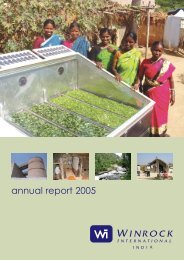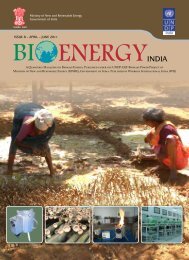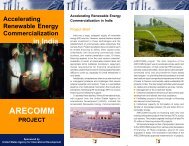ACT Apr-Jun10.p65 - Petroleum Conservation Research Association
ACT Apr-Jun10.p65 - Petroleum Conservation Research Association
ACT Apr-Jun10.p65 - Petroleum Conservation Research Association
You also want an ePaper? Increase the reach of your titles
YUMPU automatically turns print PDFs into web optimized ePapers that Google loves.
I N T H E N E W S<br />
Cabinet OKs energy<br />
efficiency plan<br />
The Union Cabinet has approved the<br />
ambitious National Mission for Enhanced<br />
Energy Efficiency, one of the eight missions<br />
under the National Action Plan on Climate<br />
Change. The mission is expected to save<br />
23 million ton oil equivalent of fuel and<br />
avoid the need to build additional capacity<br />
of over 19,000 MW.<br />
Speaking after the Cabinet approval, the<br />
Secretary, Ministry of Power said: “This is<br />
a significant development for India. During<br />
the next four years, the mission will help<br />
achieve greenhouse gas emissions reduction<br />
of 98.55 million tons per year.” The mission<br />
will also kick-start the country’s first marketbased<br />
trading in energy efficiency savings.<br />
Just like the international carbon trade, a<br />
domestic trade in energy saving certificates<br />
would facilitate this process.<br />
Source: http://timesofindia.indiatimes.com/<br />
india/Cabinet-OKs-energy-efficiency-plan/<br />
articleshow/6088416.cms<br />
India tops energyefficient<br />
cement<br />
production<br />
With some of the plants operating at the<br />
lowest energy consumption levels, the<br />
Indian cement industry has become a<br />
forerunner in energy-efficient cement<br />
manufacturing in the world, according to<br />
FE-EVI Green Business Survey 2009-10.<br />
Elaborating about the initiatives taken up<br />
by companies, FE-EVI Green Business<br />
Survey 2009-10 quotes numerous<br />
examples. Companies are also taking other<br />
initiatives to minimize their ecological<br />
footprint. These include substitution of<br />
fossil fuels used in cement kilns by fuels<br />
derived from waste, installation of waste<br />
heat recovery system, modification of the<br />
composition of cement by using cement<br />
constituents which require less energy to<br />
produce than cement clinker.<br />
Source: http://www.financialexpress.com/news/<br />
india-tops-energyefficient-cement-production/<br />
629108/<br />
India’s Ajay Mathur<br />
among energy-efficiency<br />
‘visionaries’<br />
Ajay Mathur, Director General, Bureau of<br />
Energy Efficiency (BEE), is one of the energy<br />
efficiency “visionaries” from Africa, Asia,<br />
Europe and South America to be honoured<br />
by the Alliance to Save Energy.<br />
Mathur received the award in Washington<br />
recently during a conference. Mathur is also<br />
a member of the Prime Minister’s Council<br />
on Climate Change and has been involved<br />
in driving India’s market transformation<br />
towards energy efficiency. His work<br />
includes India’s standards and labelling<br />
programme for equipment and<br />
appliances, its energy conservation<br />
building code and programs for industrial<br />
energy efficiency and demand-side<br />
management in the buildings, lighting,<br />
and municipal sectors.<br />
Source: http://economictimes.indiatimes.com/<br />
articleshow/5920414.cms<br />
Berkeley Lab Report:<br />
Simple Energy Efficiency Measures can Eliminate Electricity Shortage in India<br />
22<br />
Electricity in India can be a dicey<br />
proposition. Half the population lacks<br />
access or is too poor to afford it. The<br />
other half is using so much that demand<br />
far outstrips supply, resulting in daily<br />
power outages. As chaotic as things are,<br />
there is a solution: simple energy<br />
efficiency measures, according to a new<br />
report from Lawrence Berkeley National<br />
Laboratory (Berkeley Lab), can eliminate<br />
the electricity deficit as early as 2013.<br />
What’s more, doing so will add $505<br />
active conservation techniques<br />
billion to India’s gross domestic product<br />
(GDP) between 2009 and 2017<br />
(compared to India’s total GDP of $911<br />
billion in 2007-2008), as businesses that<br />
have had to cut back due to electricity<br />
shortages can restore production.<br />
“None of these measures are retrofits; they<br />
are all new sales of items such as light bulbs<br />
and refrigerators. We tried to keep it as<br />
simple as we possibly could—no buildings,<br />
no transport,” said report co-author Jayant<br />
Sathaye, a Berkeley Lab senior scientist<br />
who leads the International Energy Studies<br />
Group in the Environmental Energy<br />
Technologies Division. “Air conditioners<br />
alone are growing at 25% per year in<br />
India. But because of this rapid growth,<br />
you can capture the new sales, sell only<br />
efficient products and make a difference.”<br />
Source: http://newscenter.lbl.gov/featurestories/2010/05/25/energy-efficiencymeasures-can-eliminate-electricity-shortage-inindia/

















